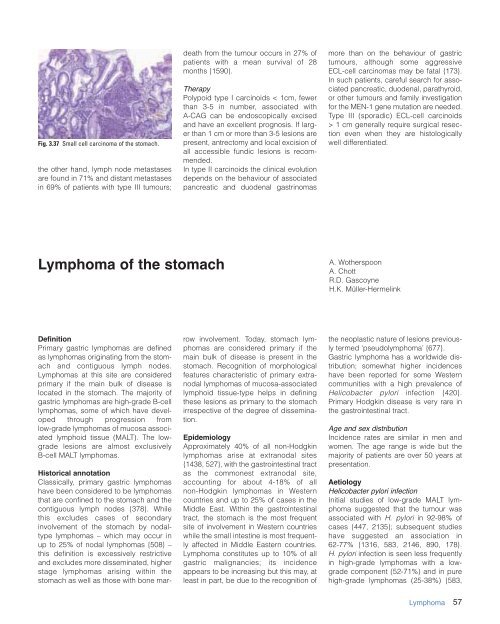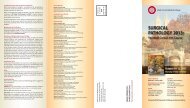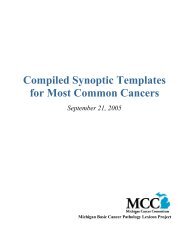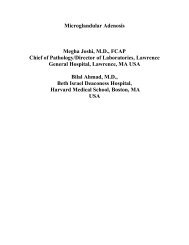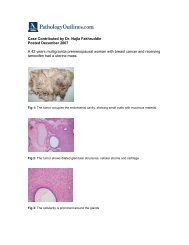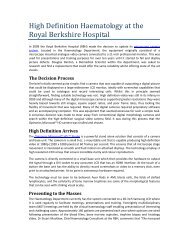CHAPTER 3 Tumours of the Stomach - Pathology Outlines
CHAPTER 3 Tumours of the Stomach - Pathology Outlines
CHAPTER 3 Tumours of the Stomach - Pathology Outlines
You also want an ePaper? Increase the reach of your titles
YUMPU automatically turns print PDFs into web optimized ePapers that Google loves.
Fig. 3.37 Small cell carcinoma <strong>of</strong> <strong>the</strong> stomach.<br />
<strong>the</strong> o<strong>the</strong>r hand, lymph node metastases<br />
are found in 71% and distant metastases<br />
in 69% <strong>of</strong> patients with type III tumours;<br />
death from <strong>the</strong> tumour occurs in 27% <strong>of</strong><br />
patients with a mean survival <strong>of</strong> 28<br />
months {1590}.<br />
Therapy<br />
Polypoid type I carcinoids < 1cm, fewer<br />
than 3-5 in number, associated with<br />
A-CAG can be endoscopically excised<br />
and have an excellent prognosis. If larger<br />
than 1 cm or more than 3-5 lesions are<br />
present, antrectomy and local excision <strong>of</strong><br />
all accessible fundic lesions is recommended.<br />
In type II carcinoids <strong>the</strong> clinical evolution<br />
depends on <strong>the</strong> behaviour <strong>of</strong> associated<br />
pancreatic and duodenal gastrinomas<br />
more than on <strong>the</strong> behaviour <strong>of</strong> gastric<br />
tumours, although some aggressive<br />
ECL-cell carcinomas may be fatal {173}.<br />
In such patients, careful search for associated<br />
pancreatic, duodenal, parathyroid,<br />
or o<strong>the</strong>r tumours and family investigation<br />
for <strong>the</strong> MEN-1 gene mutation are needed.<br />
Type III (sporadic) ECL-cell carcinoids<br />
> 1 cm generally require surgical resection<br />
even when <strong>the</strong>y are histologically<br />
well differentiated.<br />
Lymphoma <strong>of</strong> <strong>the</strong> stomach<br />
A. Wo<strong>the</strong>rspoon<br />
A. Chott<br />
R.D. Gascoyne<br />
H.K. Müller-Hermelink<br />
Definition<br />
Primary gastric lymphomas are defined<br />
as lymphomas originating from <strong>the</strong> stomach<br />
and contiguous lymph nodes.<br />
Lymphomas at this site are considered<br />
primary if <strong>the</strong> main bulk <strong>of</strong> disease is<br />
located in <strong>the</strong> stomach. The majority <strong>of</strong><br />
gastric lymphomas are high-grade B-cell<br />
lymphomas, some <strong>of</strong> which have developed<br />
through progression from<br />
low-grade lymphomas <strong>of</strong> mucosa associated<br />
lymphoid tissue (MALT). The lowgrade<br />
lesions are almost exclusively<br />
B-cell MALT lymphomas.<br />
Historical annotation<br />
Classically, primary gastric lymphomas<br />
have been considered to be lymphomas<br />
that are confined to <strong>the</strong> stomach and <strong>the</strong><br />
contiguous lymph nodes {378}. While<br />
this excludes cases <strong>of</strong> secondary<br />
involvement <strong>of</strong> <strong>the</strong> stomach by nodaltype<br />
lymphomas – which may occur in<br />
up to 25% <strong>of</strong> nodal lymphomas {508} –<br />
this definition is excessively restrictive<br />
and excludes more disseminated, higher<br />
stage lymphomas arising within <strong>the</strong><br />
stomach as well as those with bone marrow<br />
involvement. Today, stomach lymphomas<br />
are considered primary if <strong>the</strong><br />
main bulk <strong>of</strong> disease is present in <strong>the</strong><br />
stomach. Recognition <strong>of</strong> morphological<br />
features characteristic <strong>of</strong> primary extranodal<br />
lymphomas <strong>of</strong> mucosa-associated<br />
lymphoid tissue-type helps in defining<br />
<strong>the</strong>se lesions as primary to <strong>the</strong> stomach<br />
irrespective <strong>of</strong> <strong>the</strong> degree <strong>of</strong> dissemination.<br />
Epidemiology<br />
Approximately 40% <strong>of</strong> all non-Hodgkin<br />
lymphomas arise at extranodal sites<br />
{1438, 527}, with <strong>the</strong> gastrointestinal tract<br />
as <strong>the</strong> commonest extranodal site,<br />
accounting for about 4-18% <strong>of</strong> all<br />
non-Hodgkin lymphomas in Western<br />
countries and up to 25% <strong>of</strong> cases in <strong>the</strong><br />
Middle East. Within <strong>the</strong> gastrointestinal<br />
tract, <strong>the</strong> stomach is <strong>the</strong> most frequent<br />
site <strong>of</strong> involvement in Western countries<br />
while <strong>the</strong> small intestine is most frequently<br />
affected in Middle Eastern countries.<br />
Lymphoma constitutes up to 10% <strong>of</strong> all<br />
gastric malignancies; its incidence<br />
appears to be increasing but this may, at<br />
least in part, be due to <strong>the</strong> recognition <strong>of</strong><br />
<strong>the</strong> neoplastic nature <strong>of</strong> lesions previously<br />
termed ‘pseudolymphoma’ {677}.<br />
Gastric lymphoma has a worldwide distribution;<br />
somewhat higher incidences<br />
have been reported for some Western<br />
communities with a high prevalence <strong>of</strong><br />
Helicobacter pylori infection {420}.<br />
Primary Hodgkin disease is very rare in<br />
<strong>the</strong> gastrointestinal tract.<br />
Age and sex distribution<br />
Incidence rates are similar in men and<br />
women. The age range is wide but <strong>the</strong><br />
majority <strong>of</strong> patients are over 50 years at<br />
presentation.<br />
Aetiology<br />
Helicobacter pylori infection<br />
Initial studies <strong>of</strong> low-grade MALT lymphoma<br />
suggested that <strong>the</strong> tumour was<br />
associated with H. pylori in 92-98% <strong>of</strong><br />
cases {447, 2135}; subsequent studies<br />
have suggested an association in<br />
62-77% {1316, 583, 2146, 890, 178}.<br />
H. pylori infection is seen less frequently<br />
in high-grade lymphomas with a lowgrade<br />
component (52-71%) and in pure<br />
high-grade lymphomas (25-38%) {583,<br />
Lymphoma<br />
57


